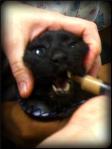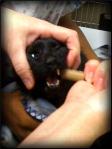How To Syringe Feed a Cat
Respect the Kitty!
Syringe Feeding an Exercise in Planning and Execution
“Why Do I Have to Put Myself and My Cat Through Syringe Feeding?”
Sometimes the difference between life and death for an unwell cat is nutrition. Syringe feeding is the slow, gentle administration of soft, soupy food through a feeding syringe, into your cat’s mouth in such a way that natural swallowing is encouraged.

Notice the towel around the body and neck, and the hand gently resting under the chin. No pressure exerted (prevents running away!)
Planning: Gather Your Supplies
6cc Oral Feeding Syringe From the Veterinarian
An oral feeding syringe is much like any other syringe, except, instead of a tiny opening where a needle attaches, there’s a gentle cone-shaped tip with an enlarged opening for thicker-than-water food to pass through. They come in various sizes, but the best size for cat feeding is “6 cc.” (5 cc is a teaspoon.)
Syringes are prescription items in the United States. Since an oral syringe cannot be used for Drug administration, your vet, medical supply stores, feed stores, or sometimes a pharmacy are sources for oral dosing syringes.
High Calorie, Soupy Food
Soft, soupy cat food. Your veterinarian can provide maximal calories per volume cat foods like Recovery formula, AD formula (alimentary diet), Maximum Calorie formula. Depending on your cat’s needs, you can also blend fresh meats with pure water in a blender to make a gruel consistency. Your veterinarian can help you calculate your sick kitty’s daily caloric needs.
Kitty Burrito
Use a towel for wrapping your kitty in a “kitty burrito.” Control of your cat’s body is a key to success. Claws and squirming will facilitate kitty escape and your failure in your endeavor. Choose a medium size towel for a 10-12 pound or less cat and a thin, but sturdy beach towel for a bounder-sized kitty. Thick, fluffy towels do not work well, because they limit your ability to feel where your cat is in the towel and they limit your holding ability. Thin, small towels do not work, because paws and arms start slashing at you from under the towel, not fun!
Planning Tru Tips
Gather your supplies. Blend the food. Have fresh water to rinse your cat’s mouth after the feeding. Measure the food intake by proportion of a can used, not by the cc’s of liquid given. You will vary amounts of liquid or water with the food each day, depending on the need at the time. If one meal is 30% water and another meal is 50% water, then cc’s fed will not help tell you caloric intake from the actual nutritious food.
Warm the Meal: No Microwaves!
Warm the food before serving. Use warm water, or place the dish or syringes of food into warm water or a vegetable steamer before serving. Do not microwave. Microwaved food has zero energetic healing ability and the microwave radiation changes the fats and proteins in the food into very difficult to assimilate forms of molecules which do far more harm than good.
Bribe Friends and Family to Help
Gather your supplies at a feeding location you can manage. Get a helper if needed to hold your cat.
Gather You Cat: Get This Right the First Time
Ready, Aim, Blanket!
Gently burrito your kitty on the blanket. Start at the neck, just behind the ears and wrap the towel around kitty medium loosely. Include paws and claws under the blanket. Tuck kitty-in-blanket under your non-dominant arm (left if you are right-handed.)
Zygomatic Arches=Kitty “Handles”

Note the hand gently wrapped over the head, and note the syringe angled up and slightly back and midway along the jaw.
With kitty tucked under your left elbow and forearm on your lap or a sturdy tabletop, grasp your cat’s head by placing your left hand (your eight hand if you are left-handed), up over the back of kitty’s head behind or just over the ears. Your thumb should be resting on your cat’s cheekbone (zygomatic arch) on the inside toward your body and your fingers should ne resting on the cat cheekbone facing away from your body. If you have cheekbone control, you have head control.
“If you have cheekbone control, you have head control,” says Doc Truli.
Execution: the Best Way to Get the Food Into Your Kitty
Approach from the Side
Lift preloaded syringe of food to kitty’s left side of the mouth. Do not approach straight on from the front! The sight of your hand and the syringe coming straight into the front, frightens most cats and triggers then to bring a paw up to bat you away. Do this with your dominant hand, as the most dexterity is needed to guide the syringe and slowly push the plunger to feed your kitty without frightening him or her.
Wiggle the Syringe Tip Against the Lips and Teeth 1/2-Way from Front to Back
Come from the side, and slightly underneath the side of the mouth. In between the sharp canine (eye) teeth and the back of the mouth, the premolars are small and short. Nudge the tip of the feeding syringe into the space between the front and back and between the jaws. Wiggle the syringe up and down and/or give a slight quarter turn at the midway location. This movement on the midway spot causes the jaw to open.
Slowly Inject the Food Upward to the Roof and Slightly to the Back of the Mouth
Slowly inject the food into the center of the mouth. Aiming at about a 15 degree angle for the roof of the mouth also promotes swallowing and helps prevent choking on the food.
Plan on Three-four Times Daily: Do Not Overwhelm Your Cat
About three ounces of canned cat food with water times maybe 6 to 9 of these syringes (5-6 cc size) in a sitting. An average 10 pound cat might need 3-4 feedings a day. Your veterinarian can accurately weigh, figure our the caloric content in the prescribed diet, and give you a starting calorie point for your cat. Every cat, disease, and diet presents a unique combination of caloric needs; follow your veterinarian’s advice.
P.S.
Did you notice the big, black, shiny pupils in this cat? Especially in the first picture? Even under the bright treatment room lights, her pupils did not constrict. Why?
This seventeen-year-old cat has chronic, long-term kidney disease, which caused secondary hypertension (which also makes the kidneys worse), and the high blood pressure caused the retinas in the back of her eyes to up and detach all of a sudden, making her just, well, suddenly blind one day last week.
There’s no reversing this. If your cat looses weight, changes urination habits, starts eating more or less, get him or her checked out. This kitty’s mom waited six months and her kidney disease was so advanced, she went blind in spite of medications, and she comes to the hospital twice daily for subcutaneous fluid administration ands syringe-feedings to supplement her poor appetite at home. On the bright side, she has gained weight, and purrs, and has started playing again!




Are you saying to feed the cat 6-9 full syringes PER SESSION??
I can barely get 1 into my cat.
Please advise.
yes, indeed. 1 little syringe is not much water. If your cat needs fluids, it is often better to get SQ or IV from the vet clinic. It is a time-consuming and painstaking labor of love to syringe a cat enough water to rehydrate them. I wrote this story because clients commonly misunderstand that and work hard to do 1 syringe. They get bit and stressed out and the cat gets stressed out, and unless you can give enough to make a difference, it is likely not worth the stress to give just a little bit.
That said, I have seen animals that are depressed and sick feel much better when their mouth is given a little water and then they start to try to eat or drink. But that is different than providing a day’s hydration needs through a syringe.
Good luck,
Dr Truli
Understand also that you need to be giving the amount of hydration your vet has prescribed for your cat and your cat’s situation.